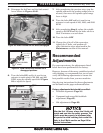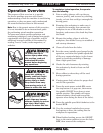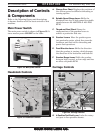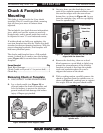
For Machines Mfg. Since 7/09 EVS Toolroom Lathes
-27-
OPERATION
Chuck & Faceplate
Mounting
This lathe is shipped with the 3-jaw chuck
installed. This is a scroll-type chuck, meaning
that all three jaws move in unison when
adjusted.
The included 4-jaw chuck features independent
jaws, which are used for square or unevenly-
shaped stock, and to mount work that needs to
be adjusted to near "0" total indicated runout.
If neither chuck can hold your workpiece, the
cast-iron faceplate has slots for T-bolts that hold
standard or custom clamping hardware. With the
correct clamping hardware, this faceplate will
hold non-cylindrical parts.
The chucks and faceplate have a D-6 camlock
mount. A chuck key is used to turn the locking
cams (Figure 40) to secure/release the chuck/
faceplate.
Items Needed Qty
Dead Blow Hammer ..............................................1
Chuck Cradle or Plywood
3
⁄4" (to protect bed) ......1
Chuck Key .............................................................1
Removing Chuck or Faceplate
1. DISCONNECT LATHE FROM POWER!
2. Lay a chuck cradle (see Figure 39) or
plywood under the chuck or faceplate and
over the bedway to protect the precision
ground surfaces from damage and reduce
injury if fingers get pinched.
Figure 39 Wooden chuck support cradle.
3. One at a time, use the chuck key to turn
each of the camlocks counterclockwise until
the cam line aligns with the cam release
datum line, as shown in Figure 40. As you
turn the camlocks, they will rise up slightly
from the spindle body.
Figure 40. Camlock loosened with the cam line
aligned with the datum line.
Cam Line
Cam Release
Datum Line
4. Remove the chuck key, then use a dead-
blow hammer or a wood block to lightly tap
around the circumference of the chuck or
faceplate to break it free from the spindle
taper and camlock sockets. Be sure to
support the bottom of the chuck.
5. With a rocking motion, carefully remove the
chuck or faceplate from the spindle nose, as
shown in Figure 41, making sure to support
the weight with an adequate chuck cradle.
Figure 41. Example of removing a 3-jaw chuck from a
spindle nose.


















